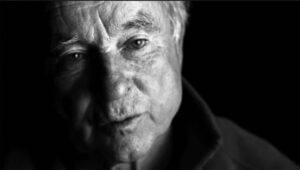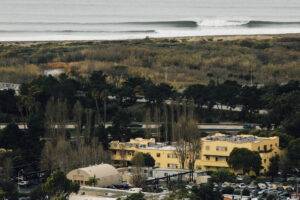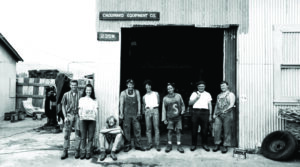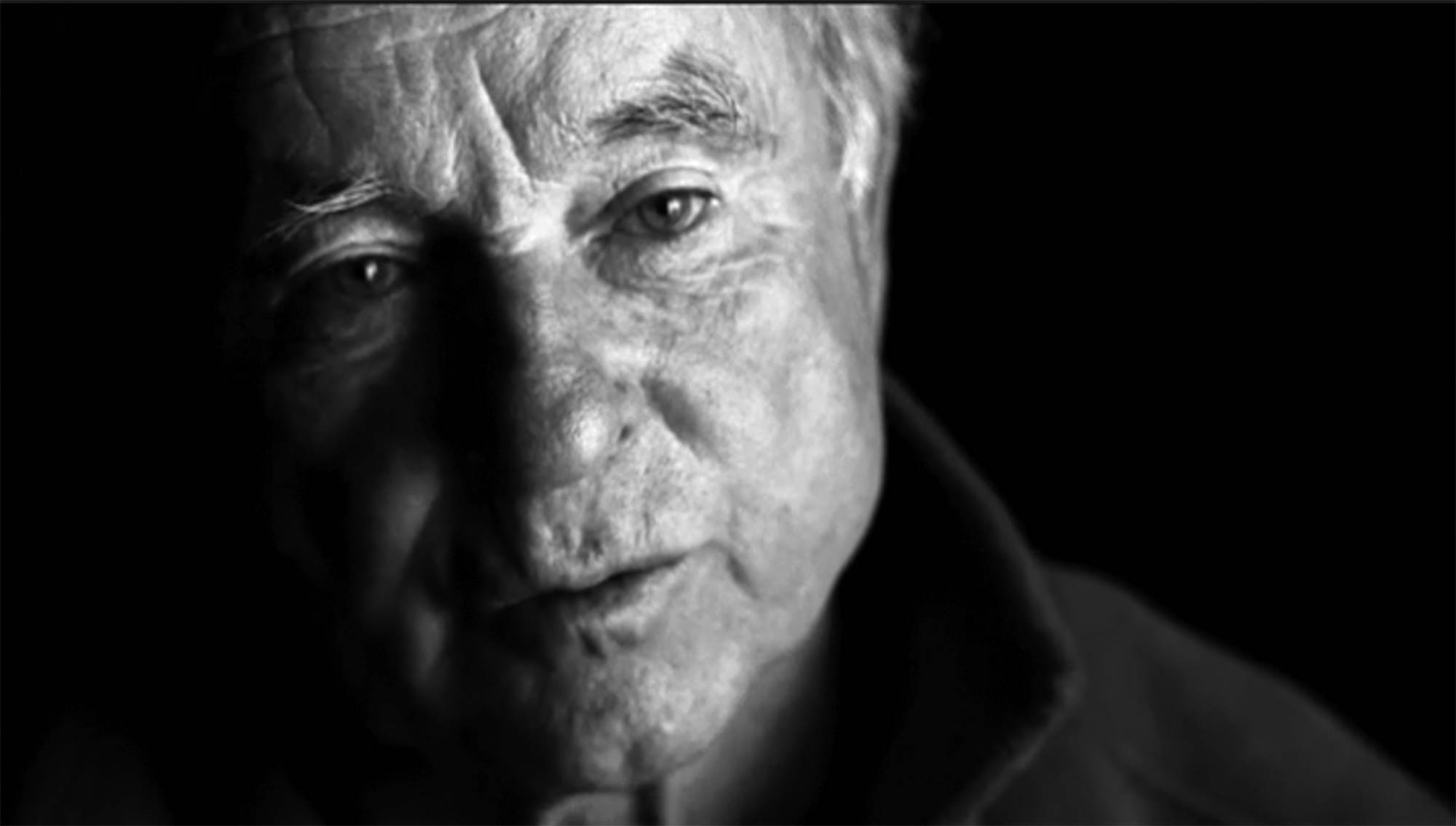FEATURE | Story by Kit Stolz
Patagonia Giving Away the Store

Patagonia founder Yvon Chouinard
On the morning of September 14, Yvon Chouinard, the founder and owner of Patagonia, spoke to several hundred Patagonia employees and former employees at Patagonia’s Brooks campus in Ventura. In an address taped and transmitted to Patagonia stores and employees around the world, Chouinard announced that he and his family, the owners of the voting shares of Patagonia stock, will give the Patagonia corporation, worth an estimated $3 billion, and all its revenues, estimated to be about $100 million a year, to a new non-profit holding company called the Holdfast Collective. The Holdfast Collective, which will be headquartered in Ventura, will donate Patagonia’s approximately $100 million in annual profits to non-profit environmental groups focused on reducing the harms of climate change and on preserving habitat and wildlands. Patagonia has already endowed the collective with an initial grant of $50 million, with $100 million more expected this fiscal year and in years to come.
Patagonia will remain a for-profit company, overseen by the Chouinard family — who are the voting stockholders in a trust, the Patagonia Purpose Trust, which retains 2 percent of the company — in order to continue to generate revenues and fund environmental actions.
The company, estimated to be worth about $3 billion, will not be sold, because Chouinard has a low opinion of the stock market and corporations focused on short-term profits.
Dr. Geoffrey Jones, a historian at the Harvard School of Business who has written about Chouinard and Patagonia, said that this gift of a major corporation to a charitable cause is unprecedented in American history.
“I believe this is a first in the US, but not in Europe,” he said, mentioning for comparison the Bosch auto parts company in Germany and the John Lewis Partnership, a retailer, in the United Kingdom.
In an interview with the New York Times, Chouinard spoke bluntly about why he gave away the company.
“Hopefully this will influence a new form of capitalism that doesn’t end up with a few rich people and a bunch of poor people,” Chouinard, now 83, told the Times. “We are going to give away the maximum amount of money to people who are actively working on saving the planet.”
Patagonia stores around the world — 34 in the U.S, 109 stores in total — closed for a day, and Patagonia employees came into their workplaces to see the recording of Chouinard making the announcement about the future of the company. The news about the new holding company was kept secret from all but a few executives: at the Brooks campus the announcement kicked off a celebration.
“They kept the news incredibly secret,” said Tania Parker, the deputy director of the Ojai Valley Land Conservancy, which has been supported by Patagonia, both by small annual contributions, and by employees who are paid by Patagonia but volunteer for assignments at the Conservancy.
“Even the Patagonia staff working there didn’t know about it. I was just blown away. As soon as the news was announced, my phone started blowing up with people sending me the (NY Times) article.”
Kim Stroud, who worked for Patagonia in Ventura for many years, and remains close to the company, as she developed and launched the non-profit Ojai Raptor Center, said that Yvon wanted to break the news to the whole company at once. She added that he’s always had doubts about capitalism with a capital “C.”
“Yvon has always been kind of against capitalism,” she said. “At least the way it’s currently run. Patagonia will continue as a business. We’re not really anticipating a great number of changes, but the Holdfast Collective will be a separate non-profit, with its own board of directors and mission.”
Although the company’s business “core values” have not changed since its early days, in 2018 Patagonia announced a new mission statement: “We’re in business to save our home planet.”
Patagonia insiders say that in truth it’s not a new idea: Chouinard was giving Patagonia company profits away to small non-profit environmental groups long before the company became prosperous, a decade before the company had formalized its philanthropic ideals.
It all began with the Ventura River, and a handful of activists trying to save the river from being transformed into a channel made of concrete, which was the fate of the Los Angeles River.
PATAGONIA’S FIRST ENVIRONMENTAL GRANT
In an outtake for a talk filmed for what eventually became an American Express commercial in 2010, Chouinard explained how Patagonia became involved in the fate of the river.
“In the ‘70s, the City (of Ventura) wanted to channelize the Ventura River, and there was a city council meeting, so we decided to all go, because we were concerned about the sand flow,” he said. “So we showed up and there were all these scientists there saying
it’s not going to hurt the river because it’s a dead river. So just forget about it. And at the end of the talk, a young grad student got up and showed a slide show of all the life along the river; all the eels, and the birds that nest along the river, and the raccoons, and there were still 50 steelhead who went up that polluted river every year. It wasn’t dead at all. And that brought the house down, and it showed me what one individual can do.”
That “young grad student” was a biologist named Mark Capelli, who went on to become the Steelhead Recovery Coordinator for the National Marine Fisheries Council, where he still works today. He recalled a subsequent conversation with Chouinard back in the 1970s that changed his life.
“On a late afternoon 40-plus years ago I bumped into Yvon leaving the parking lot where the Friends of the Ventura River had their office in the Patagonia headquarters,” he said. “Our conversation only lasted a couple of minutes, and Yvon may have forgotten it ever occurred.”
After a brief discussion of the surf at Rincon Point, because both Capelli and Chouinard were surfers, Capelli asked Chouinard for a small donation to defray the costs of a lawsuit contesting an agreement between the City of Ventura and Casitas Municipal Water District to divert almost all of the Ventura River into the Casitas reservoir. This meant the river would go dry in stretches in the summer, which would devastate its wildlife, and likely end the remaining steelhead run.
“Without hesitation, Yvon said sure, how much do you need,” Capelli recounted. “I said about $3,000. He said just go up the stairs and have Clovis — who was Patagonia’s bookkeeper at the time — write you a check.”
The safe had already been closed for the day, it turned out, so the bookkeeper wrote Capelli the check the next day. “This financed the case all the way through to the California Supreme Court and prevented the dewatering of the Ventura River,” Capelli said.
It was the first environmental grant Patagonia ever made,” Capelli added. “Yvon was so impressed with the return on his “investment” that he later initiated the “1 percent for the Planet” program, which has now culminated in Patagonia’s recent planetary grant.”
HOW PATAGONIA FUNDS OVER 1,100 ENVIRONMENTAL NON-PROFIT GROUPS

“Let my people surf” gets thrown around a lot during an El Nino year. Patagonia corporate headquarters in Ventura, California January 19, 2016.
In Ojai, Tom Maloney, the executive director of the Ojai Valley Land Conservancy, said that even a month after hearing the surprise announcement that Yvon was giving away Patagonia, he still can’t talk about it without tearing up.
“It’s a little crazy,” he said. “But that’s the way I feel about it. I think it’s a transformational change. At least I hope it’s a transformational change.”
The Ojai Valley Land Conservancy that he leads garnered $24,000 in grants from Patagonia in 2019, the most recent year for which tax records for such donations are available from the IRS. Maloney said that Patagonia prefers to donate to activists, rather than towards land acquisition, but he thinks that Patagonia recognizes that the Land Conservancy is working to “enhance natural capital,” including fish and wildlife, as it works to protect the lands around the town.
“I want to live in a world that includes steelhead in an intact watershed,” Maloney said.
In Oxnard, Lucas Zucker, the communications director for the non-profit organizing outfit CAUSE, the Central Coast Alliance for a Sustainable Economy, said that although Patagonia’s support — which totalled $15,000 in 2019 — adds up to no more than a small fraction of his organization’s budget, their willingness to fund environmental justice campaigns and to challenge the powerful oil and gas industry in Ventura County has made them invaluable.
“Patagonia was our first funder in the westside power plant campaign against the Puente Power plant proposed for Mandalay Beach by NRG Energy (in 2014),” he said. “This was a four-year battle led by us and environmental groups against the largest power plant operator in the U.S. No one thought that a low-income heavily immigrant community up against a huge company would ever win. It’s very rare that these plants ever get rejected.”
Zucker said that CAUSE had not been directly funded by Patagonia before taking on the fight against NRG Energy.
“This was an environmental justice issue in their backyard,” he said. “Because Patagonia has a culture of paying their employees to volunteer for environmental causes, employees came to south Oxnard. They saw the pollution and their staff was exposed to the community abuse there and they realized, hey, we need to prioritize equity, we want to see more of a diversity of organizations being funded, not just traditional environmental groups.”
Although Patagonia the corporation has long funded environmental groups, the corporation has also empowered employee volunteers at the retail stores to form councils to judge the smaller grant applications that are submitted in a local area. Every few months the employees grant council will meet after hours, on salary, to go over a stack of grant applications and determine which groups deserve funding. Zucker thinks the employees grant councils in Ventura pushed the company to take a harder stand against oil and gas companies than they had in the past.
“It’s rare for companies in the private sector to take on the oil and gas sector,” he said. “Oil and gas companies will spend millions of dollars and turn out their employees for governmental meetings. Patagonia has become kind of a countervailing force in Ventura County, as they realize that if they’re really about saving the environment, then they’ve got to get just as involved as the polluters.”
This year, in the most expensive ballot proposition fight in the history of Ventura County, the oil and gas industry, led by Aera Energy, spent a total of $8.2 million dollars over three years to overturn regulations on the industry imposed by the Board of Supervisors in November of 2020. These measures required oversight and permitting on all oil wells, even those drilled in the wildcat days before environmental laws such as the Environmental Protection Act. Powered by over $6 million in advertising, and claiming the oversight would “shut down” the industry, the industry won a hard-fought election by fewer than 6,000 votes out of over 200,000 cast, or about three percent.
In the weeks before the June election, Patagonia donated $455,000 to the Westside Clean Air Coalition, in which a number of environmental and community groups, including CAUSE, came together to campaign for the proposition against the oil industry.
Among those groups was CFROG (Climate First: Replacing Oil and Gas), currently led by Haley Ehlers. Ehlers, who said that Patagonia granted CFROG $10,000 in 2020, said that Patagonia’s substantial support for advertising and get-out-the-vote efforts on behalf of Propositions A + B “gave the Coalition a chance against Big Oil.”
“They’re generally very supportive of our efforts. Their employees actively participate in the Westside Clean Air Coalition,” she said. “They’re great in their willingness to support our meetings and efforts, and I would say that it’s unique for a for-profit business, not a community foundation, to support environmental justice and not be afraid to stand up against fossil fuels.”
For Hans Cole, the current Vice-President of Environmental Activism at Patagonia, this willingness to fund large campaigns against fossil fuel industries speaks to the reason the Holdfast Collective was created in the first place.
“Frankly, the scale of our participation in the 1 percent for the Planet focuses on small grassroots grants,” he said. “These grants usually range from $10,000 to $20,000. The collective will continue to support those grants and values and the community engagement, but I think the scale of the grants from the Holdfast Collective can be larger, in the hundreds of thousands or over a million for particular grants.”
In 2019, according to tax records, Patagonia contributed small grants from its 1 percent for the Planet fund to over 1,100 organizations around the country and the world, adding up to a total of $28,619,329.
In the future Cole said that the Holdfast Collective will donate about $100 million a year to environmental causes and climate action. Under IRS rules the Chouinard family chose to establish the new organization as a 501(c)4 charity, which allows for political activity and lobbying, and not the more conventional 501(c)3 charity, which limits political activity on the part of grantees. The family could have enjoyed a substantial tax break, had they chosen the more conventional route, but instead paid $17.5 million dollars to establish the Holdfast Collective as an entity that can fund political activities on behalf of the environment without restriction.
“Patagonia prides itself on paying its taxes,” Cole said. “We have actually advocated for increased corporate tax rates to enable more dollars to come to things like climate funding at the national level. We believe in taxes. And I can tell you there was never a time when Yvon or the family or our leadership ever said to me or anyone working on this, hey, let’s try to lower our tax burden. Truly, that was never part of the decision-making.”
Cole pointed out that in 2018, when the Trump administration passed a huge tax break for corporations, instead of taking profits, as did most corporations and corporate officers, Patagonia donated its $10 million in tax savings to groups fighting the climate crisis.
Cole added that also this year, concurrent with the announcement that Patagonia was giving the company away to a non-profit holding collective, Patagonia initiated another new fund, a 501(c)3 non-profit called the Home Planet Fund, which will be backed by an initial donation from the corporation in December of $20 million.
“The reason we helped create this fund, which is a public charity, a 501(c)3, is because that entity, as a separate public charity, can receive donations,” he said. “Each of these funding entities, whether it’s the Holdfast Collective, or 1% for the Planet, or the Home Planet Fund, has capabilities that we believe can help advance and put more resources towards our mission.”
THE LOCAL REACTION
Caryn Bosson, a grant writer from Ojai who became an expert in non-profit governance working as a founder and executive director for the Ojai Youth Foundation in the 1990s, as an executive for many years with the non-profit TreePeople in Los Angeles, and for The C.R.E.W. in Ojai, sees the giving of an entire multi-billion corporation to planetary health as “super inspirational.”
“I think this is how we have to go forward at this moment in history,” she said. “This is a time to invest in the planet, and to demonstrate what’s truly important in the world. I hope this will be a model for other corporations, because what’s the point of holding on to piles and piles and piles of money, when so much is being destroyed all around us?”
Several local non-profit leaders, including Haley Ehlers of CFROG, Jeff Kuyper of Los Padres ForestWatch, and Alasdair Coyne of Keep the Sespe Wild, spoke gratefully of Patagonia’s willingness to support small grassroots groups engaged in political actions or lawsuits. Often businesses and community foundations shy away from that sort of controversy, they said.
“Businesses are often willing to support conservation efforts or cleaning up the beaches or create living trusts, but when it comes to environmental justice or climate action most businesses aren’t interested,” Ehlers said. “Patagonia is definitely not afraid. They’re willing to put their influence and their logo on the line. And when other donors see that Patagonia supports us, that confidence on their part influences other people to give.”
Patagonia, or its part, shows no signs of backing down. When asked for an example of the sort of environmental action we might see the Holdfast Collection take in the future — the sort of action that Patagonia in the past has not taken — Cole pointed to Patagonia’s donation of nearly half a million dollars to take on the oil and gas industry in the election this June over Propositions A + B, a far greater contribution to one cause than the corporation has made in the past through One Percent for the Planet. Patagonia believes that the planet is in crisis, and is giving all it can to restore its health and balance.
“If we have any hope of a thriving planet — much less a thriving business — 50 years from now, it is going to take all of us doing what we can with the resources we have,” Chouinard wrote in a public letter explaining the gift of Patagonia to the planetary fund. “This is another way we have found to do our part.”

Patagonia’s legendary barn
TIMELINE:
1960’s: Yvon Chouinard, a competitive rock climber, takes up blacksmithing to improve the quality of steel pitons and climbing gear. He quickly establishes a reputation for worth and reliability, and begins selling climbing gear to other climbers out of the back of his car.
1970: Chouinard Equipment is the leading supplier of climbing equipment in the U.S., with an excellent reputation for quality, but meanwhile Chouinard has seen that his steel pitons are scarring rock faces in Yosemite and on other climbing routes. He finds an alternative, aluminum chocks, that doesn’t damage the rock, and abruptly stops selling pitons.
1972: In Chouinard Equipment’s first catalog for the public an article is published calling for “clean climbing” using gear that doesn’t mar rock faces. With just a handful of employees, including Chouinard, the company sets up shop in a tin shed in Ventura, not far from the surf.
1973: Chouinard launches Patagonia, an adventure clothing company. Originally intended to support the climbing equipment company, Patagonia’s clothing line soon became dominant in sales. (Chouinard Equipment struggles with low profit margins for years, eventually goes bankrupt under legal pressure, but is bought out by its employees. It’s rebranded and successfully relaunched as Black Diamond in 1989.)
1973: In its first environmental action, Yvon Chouinard in a moment agrees to give Mark Capelli and Friends of the Ventura River $3000 to file a lawsuit to prevent the city of Ventura from “dewatering” the river near its headquarters. This action saves the wildlife in the river.
1979: Patagonia names Kris McDivitt its first CEO. Under her leadership, the company innovated with fleece clothing, bright colors for adventure wear, and polyester fabrics, among other new ideas. Sales boom, going from $20 million to $100 million in revenue in the 1980s, and the company began expanding into Europe and Japan.
1984: Patagonia launches a childcare facility for its corporate employees in Ventura, one of the first corporations in the nation to do so.
1985: Yvon and Malinda Chouinard develop a new form of fleece, called Synchilla, with Polartec, as an alternative to heavy wool sweaters. Synchilla becomes an industry standard.
1986: Patagonia formalizes its long-standing practice of donating to small nonprofits devoted to habitat restoration and environmental causes by announcing a policy of annually giving 10% of its profits to environmental organizations.
1991: After growing its revenue from 30-50% a year throughout the 1980’s, the end of the decade brought a recession that cut growth at the company in half. Under financial pressure from lenders, the company retrenches. In July Chouinard reluctantly laid off 120 employees, which was at the time nearly one-fifth of the company.
1991: Led by Chouinard, Patagonia launches a lengthy full-scale rethinking of its own philosophy, working to control its growth to about 5% a year, and intending to create a model for environmental stewardship and sustainability that other businesses could look to for guidance.
1996: After years of research and preparation, Patagonia moves to 100% organic cotton, rethinking the product line to reduce the necessarily higher material costs.
2000s: Patagonia has always offered “ironclad guarantee” and a willingness to take back defective products, but this decade they extended that guarantee by offering to repair damaged items that are returned for free. Patagonia in time offers a “Worn Wear” option in which they buy back and resell Patagonia items at a reduced cost.
2002: With renowned fly-fisher and friend Craig Matthews, who owns the company Blue Ribbon Flies, Chouinard and Patagonia partner in a new effort called 1% for the Planet, which enlists for-profit corporations to pledge 1% of their total sales annually to environmental action. This “earth tax” that they vow to pay is equivalent to (or greater than) Patagonia’s earlier pledge of 10% of profits, and the 1% of sales turns out to be a figure more resistant to manipulation.
2009: On Black Friday, Patagonia runs a full-page ad in the New York Times, urging people “Don’t Buy This Jacket.” Sales on that day soar, ironically, convincing Patagonia of the link between environmental ethics at the company and public perception of the worth of its products.
2011: An internal audit discovers examples of “human trafficking, forced labor, and exploitation in Patagonia’s supply chain” among 2nd and 3rd tier supplies based in Taiwan. Led by Rick Ridgeway, an Ojai resident and Patagonia executive, the company goes public with the issue. “We have to tell people about the problem. We have to get the supply chain involved. We have to get the government involved. You can’t fix a system without all the players coming together. That is our default position,” Ridgeway later explained to a Harvard researcher.
2011: Patagonia joins a new standards movement for transparent and ethical corporate behavior, called the “B Corporation,” in which corporations pledge to follow a “triple bottom line” ethos that calls for respecting people and the planet as well as profit, with verification audits.
2018: After passage of legislation from the Trump administration that dramatically lowered the corporate tax rate, “Patagonia took the $10 million they received from that tax break and donated it to groups fighting the climate crisis,” said Hans Cole, VP of environmental activism.
2020: Thinking of how best to position Patagonia for a future of environmental action, Chouinard thinks of selling the company, and tells Patagonia CEO Ryan Gellert that he’s ready to start cold-calling fellow billionaires. But he wasn’t happy with their response. “So we created our own [plan],” he wrote in his letter released this September, to “save our home planet.”
2022: A survey by a business group, the Edelman Trust Barometer, found that most people felt capitalism was more harmful than helpful. The Chouinards’ grown children Fletcher and Claire agree. They told Patagonia CEO Gellert that they didn’t want to inherit the company, worth about $3 billion, because they didn’t want to be seen as benefiting from capitalism.
“They felt very strongly about it,” Gellert, the CEO of Patagonia, said. “I know it can sound flippant, but they really embody this notion that every billionaire is a policy failure.”
From “Let My People Go Surfing,” Yvon Chouinard’s memoir, and other linked sources.


Leave A Comment